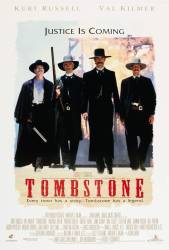Trivia: Val Kilmer has been quoted as saying that screenwriter Kevin Jarre insisted the actors wear real wool costumes, in accordance with the time period. During the scene in the Birdcage Theater, Val Kilmer says, a thermometer was placed on the set, and it read 134 degrees Fahrenheit. Kilmer suggested jokingly that this was the reason Doc Holliday killed so many people: "It's just, like, he wore wool in the summer, in the Arizona territory, and that made him mad."
Trivia: Val Kilmer is widely believed to be the most historically accurate portrayal of Doc Holliday. He is the same height, same build, and uses phrases used by Doc Holliday (eg "I'm your huckleberry" and "You're a daisy if you do").
Trivia: The expression "I'm your huckleberry" spoken by Doc means "I'm the perfect man for the job." It is not a reference to Mark Twain's Huck Finn, as that book was published in 1885 and this movie takes place in 1881.
Trivia: During filming Val Kilmer and Kurt Russell became good friends. One bought a grave slot in the actual Tombstone for the other and the other bought a piece of property in the town for the other. The fun thing is that neither knew that the other had bought them anything until they exchanged "gifts".
Trivia: Val Kilmer can be seen at the Casino doing his famous "coin flip" trick over his knuckles, except using a poker chip in place of a coin. He does this once in almost every film he starred in during the 80's through the 90's. It's quite impressive, and something fun to look for in his movies.
Trivia: When Wyatt is at the train station standing on the loading platform, giving Ike Clanton his "you tell em' I'm comin', and hell's comin' with me" speech, really going crazy on Ike, he's standing in front of train car 5150 (the California police code for a crazy person).
Trivia: Billy Claiborne is played by an actor named Wyatt Earp, who is a distant relative of the real Wyatt Earp.
Trivia: In the scene when Sam Elliott is shot and staggers into the bar and falls, when they pick him up, they accidentally slam his head into the underside of the bar.
Trivia: In reality, Fred White did not die the night he was shot. In fact, it was his testimony that the shooting was accidental that led to the freeing of "Curly" Bill, not a "lack of witnesses" as shown in the film. He died two days after he was shot.
Trivia: Just before the famous O.K. Corral shootout, Wyatt retrieves his gun from home. The gun shown is a 12-inch barrel Peacemaker, but Wyatt received a custom 10-inch version from the people of Dodge City. The armourer who supplied the guns for the film could not find a 10-inch specimen, and therefore used a 12-inch version. This fact was stated in an issue of Guns and Ammo magazine. Incidentally, the man who plays Texas Jack was the technical consultant on the film.
Trivia: Billy Bob Thornton was told to act like a bully and ad-libbed his constant tirade during the poker game with the other players.
Trivia: Jon Tenney, who plays Sheriff Johnny Behan, is using the real Behan's actual pistol, a 4 inch Colt Sheriff's Model, in the film. Screenwriter Peter Sherayko tracked it down and purchased it in order to end an argument between him and co-writer Kevin Jarre over the type of pistol Behan had used.
Trivia: When Doc is playing poker in Prescott, AZ with Ed Bailey, (and our first introduction to him), he says, "Hmm. Five hundred. Must be a peach of a hand." This quick remark references his roots in Georgia where he probably practiced dentistry before he became ill.






Suggested correction: But Hucleberry Finn appeared in Tom Sawyer in 1876 and was a bad influence on, or "made trouble' for Tom.
Not sure what this correction is trying to state, but "I'm you're Huckleberry" was slang in the late 1800's for "I'm your man" and didn't derive from Twain or Huck Finn. Twain uses the earlier slang meaning of huckleberry for Finn, meaning an inconsequential person, to establish Finn is a boy of lower extraction or degree than Tom Sawyer.
Bishop73